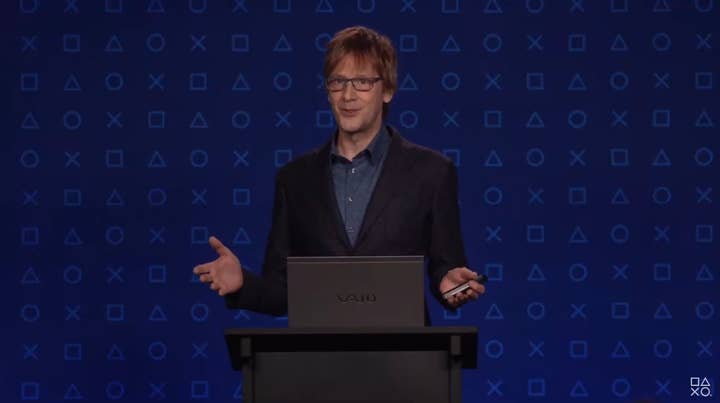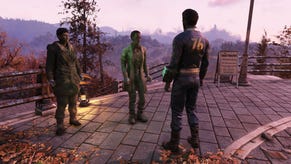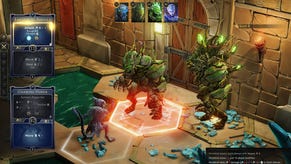Sony lays out more PS5 details
Mark Cerny talks about the promise of system's 825GB SSD and Tempest 3D Audio Tech, offers details on backwards compatibility and expanded storage
PlayStation 5 system architect Mark Cerny today delivered a presentation on "The Road to PS5," talking in detail about Sony's philosophy in putting together the hardware and some of the specs it believes will be key for developers and players alike.
Cerny began his talk by laying out the three guiding principles Sony followed in designing the PS5: listening to developers, balancing evolution and revolution, and finding new dreams.
On the first principle, Cerny said he makes a point every couple of years of touring roughly two dozen developers and publishers around the world to find out what they want out of new hardware. The most requested feature he heard from them was one of the first Sony revealed when it announced the PS5, a solid-state drive (SSD) for storage.
Cerny talked about the PS4 hard drive, saying "boot times and load times can get pretty grim" on the system, with developers able to load about 1GB of data in 20 seconds. By comparison, the PS5 can load 2GB in .27 seconds.

Beyond the potential for reducing loading screens, Cerny said using an SSD could change the way game designers think about games. In previous generations, Cerny said developers have had to mask loading screens, pointing to Spider-Man's subway cutscenes when using fast travel as one example, or lengthy winding corridors between large areas in Jak 2's open world as another.
With an SSD, Cerny said it's possible to load things in the world as quickly as the player turns around. Beyond that, he said the SSD should remove the necessity for a lengthy patch installation process after downloading, and should allow developers to get much more use out of the system's RAM.
While the PS5 will come with an 825GB SSD, Cerny said there are options for customers who want to expand that
The PS4 had 8GB of RAM that Cerny said would often be needed to store everything that might be needed in the next 30 seconds of gameplay. The PS5 doubles that to 16GB of RAM, but the SSD allows data to be moved to and out of it so quickly that it would only need to store everything the game might need in the next second or so.
While the PS5 will come with an 825GB SSD, Cerny said there are options for customers who want to expand that. They can use a large external hard disk drive (HDD) that would be suitable for storing PS4 titles, but PS5 games would need the faster transfer speeds of an SSD.
Sony will support certain M.2 SSDs that can be installed in a bay in the PS5, but Cerny said the PS5 needs them to support the system's features as well as physical dimensions. Sony will be doing compatibility testing to find out which M.2 drives will be suitable once PS5 launch games reach beta testing, and he believes an official list of compatible options won't be ready until after the hardware's launch.
On the topic of balancing evolution and revolution, Cerny said Sony wanted to add new features and improve the efficiency of development, but at the same time it was important to feature backward compatibility with the PS4 and provide a familiar environment for developers.
Cerny believes "almost all" of the top 100 PS4 games will be playable in boosted mode on PS5 at launch
To that end, Cerny said it was important that all of the system's new features like ray-tracing and primitive shaders would be optional. And as for backward compatibility, the PS5 GPU has the ability to run in legacy modes for the PS4 Pro and standard PS4.
PS5 backward compatibility will also allow some PS4 titles to run in a "boosted" mode. However, some titles simply won't work in boosted mode and testing on those is being done on a title-by-title basis. Cerny said he expects "almost all" of the top 100 PS4 titles to be playable on PS5 systems in boosted mode at launch.
Cerny wrapped up by talking about the final guiding principle of PS5 development, "finding new dreams." As he explained it, that's the catch-all category for things that developers didn't necessarily ask for but Sony believes could be important to them in the years to come.
One example of such a feature for the PS5 has been a focus on 3D audio. Cerny talked about the company's Tempest 3D Audio Tech, which he said aims to give players a sense of "presence and locality."
The idea behind Tempest is that people know where sounds are coming from because of how sounds are changed by the specific acoustics of their own ears and heads, and that those changes can be mathematically mapped out in a head-related transfer function (HRTF).
PS5 will have five different 3D audio profiles to choose from at launch
Given a person's HRTF, Cerny said the PS5 can then reproduce more convincing 3D surround sound. He testified to the effectiveness of the technology, saying that when using headphones and his own custom-mapped HRTF, he has been fooled and enjoyed moments of the presence and locality feeling he's pursuing.
The equipment used to properly map a person's HRTF is pricey and impractical to roll out for a console's consumer base, but Cerny said the PS5 will offer five different HRTF profiles at launch that users can quickly test themselves to find out which works best for them.
He added that the technology is working well on headphones at the moment and that will be the gold standard for PS5 audio. Sony also has a virtual surround sound version of the technology up and running on TV speakers if users are sitting directly in the "sweet spot," but it is working to increase the size of that spot and improve the effect.
Once Sony gets Tempest 3D Audio Tech working on standard TV speakers, it plans to start working on surround sound set-ups.
Cerny called Tempest "a journey we'll all be taking together over the next few years," suggesting that it might be possible for people to get more customized HRTF profiles for users by having machine learning algorithms create them based on photos or videos of users' ears, or other such work-arounds.
"Now comes the fun part," Cerny said in closing. "We get to see how the development community takes advantage of that feature set."
This article originally stated that Cerny expected most top PS4 titles to be playable on PS5 at launch. Cerny was specifically referring to those games being playable in boosted mode on PS5, not being playable at all.








